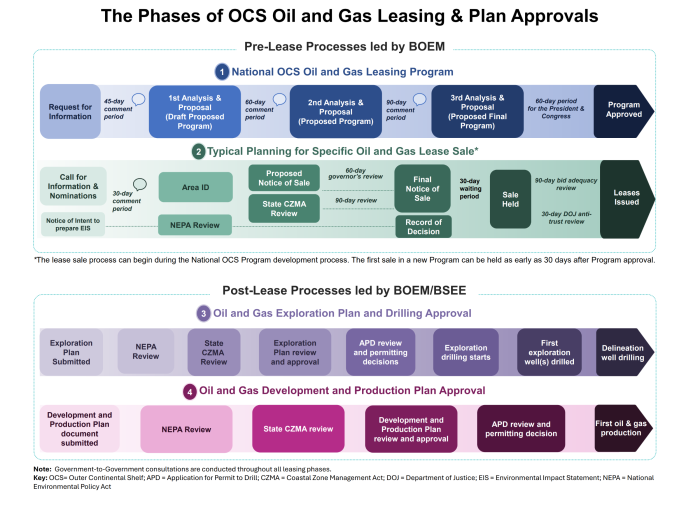BOEM has oversight responsibility for OCS oil and gas leasing and development starting with the development of the National OCS Program (Phase 1). Section 18 requires the Secretary to prepare an oil and gas leasing program that consists of a 5-year schedule of proposed lease sales that the Secretary determines best meets national energy needs.
For any specific lease sale to be held, it must be included in an approved National OCS Program. A lease sale cannot be added later to an existing National OCS Program without an act of Congress. Whether a lease sale is held depends on sale-specific analysis (Phase 2). Following a lease sale, BOEM performs a review and either accepts or rejects bids within 90 days.
Once granted, an oil and gas lease conveys the exclusive right to explore, develop, and produce oil and/or gas for a specific initial period (for a minimum of 5 and maximum of 10 years) from a specific OCS block. All exploration (Phase 3), development, and production plans (Phase 4) are carefully reviewed by BOEM.
National Program Development
Under Section 18 of the Outer Continental Shelf (OCS) Lands Act, the Secretary of the Interior is responsible for approving a schedule of OCS oil and gas lease sales for a 5-year period.
The approved schedule is called the National OCS Oil and Gas Leasing Program (National OCS Program). BOEM is responsible for developing the National OCS Program, advising the Secretary, and administering the National OCS Program once approved.
- Winnowing of available lease areas typically occurs during each of the analytical phases.
- Specific OCS Lands Act Section 18 requirements and factors are evaluated to determine which areas to include in a potential lease sale schedule.
- These requirements include the size, timing, and location of proposed lease sales to best meet national energy needs.
National OCS Program Development Process
Request for Information and Comment (RFI)
- Requests information and comments from all stakeholders regarding all 27 planning areas
45-day Comment Period
Draft Proposed Program – 1st Analysis & Proposal
- Presents analysis of all 27 OCS planning areas
- Presents the Secretary's 1st Proposal, which could narrow areas that will remain under leasing consideration
60-day Comment Period
Proposed Program – 2nd Analysis & Proposal
- Presents analysis of the 1st Proposal
- Presents the Secretary’s 2nd Proposal, which could narrow areas that will remain under leasing consideration
90-day Comment Period
Proposed Final Program – 3rd and Final Analysis & Proposal
- Presents analysis of the 2nd Proposal
- Presents the Secretary’s 3rd and Final Proposal
60-day Waiting Period for the President and Congress
Approval
- New National OCS Program is approved by the Secretary, and a decision memo is posted
Lease Sale Decisionmaking Phase
A lease sale must be included in an approved National OCS Program or be otherwise required by law to be held. The lease sale process includes further stages of analysis, public input, and decisionmaking.
A lease conveys the rights to explore for, develop, and produce the oil and gas contained within the lease area. The lease is a contractual agreement and defines requirements for surety bonds, royalty payments, rental payments, and assignment or other transfers. Once granted, an oil and gas lease gives the lessee a primary lease term to explore for and develop oil and gas resources. Primary terms range from 5 to 10 years, depending on water depth, and are used to ensure due diligence in exploration and development of the lease. A lessee must relinquish the lease if no activity has occurred within a specified amount of time.
All exploration, development, and production plans are carefully reviewed by BOEM. Once lessees receive plan approval from BOEM, the Bureau of Safety and Environmental Enforcement (BSEE) then exercises primary oversight of all permitting and operational activities (e.g., drilling and production). The pre- and post-lease processes are shown in the figure below.




